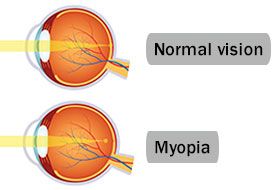Myopia Blog

Does your child's prescription seem to get worse year after year? Childhood myopia (nearsightedness) is on the rise and it's more than just needing stronger glasses.

Specially designed multifocal contact lenses adjust the distance focus just like a regular contact lens, but they also adjust the way vision is focused at intermediate and near. These specific adjustments ultimately result in slowing the elongation of the eye…or slowing the progression of myopia.

here are a number of studies that show Atropine in 1.0% concentration can control the progression of myopia up to 75% or more. However, there are many side effects to using the drop at this concentration, including pupil dilation which causes increased light sensitivity and the inability to focus on near objects.

Orthokeratology is the fitting of a specially designed gas permeable contact lens or mold that is worn overnight. The mold gently reshapes the cornea (front surface of your eye) so that when the lens is removed in the morning, vision is clear, and daytime glasses or contacts lenses are not needed. It is similar to how braces or retainers work for teeth .

Myopia or nearsightedness is generally caused by the eyeball growing too quickly. This causes light to enter the eye and focus in front of the retina which causes distance vision to be blurry.

Myopia management is a growing area of eye care focused on slowing the progression of childhood myopia. Myopia (nearsightedness) most often occurs when the eyeball grows or elongates over time. This causes vision at a distance to become blurry. Once a child becomes myopic, progression tends to occur. Also, the younger a child becomes myopic, the greater the chance for progression and higher amounts of myopia.







